Conflict Resolution Techniques in Organizations
VerifiedAdded on 2023/04/04
|12
|2584
|103
AI Summary
This essay discusses various conflict resolution techniques used in organizations, including conciliation, arbitration, negotiation, collective bargaining, and restorative justice. It emphasizes the role of HR professionals in conflict management and highlights the importance of effective workplace resolution mechanisms in improving communication and team functioning. The essay also explores the skills required by HR professionals to handle conflicts and the benefits of cooperative and productive workplace programs. Role plays are discussed as a valuable tool for learning conflict resolution strategies.
Contribute Materials
Your contribution can guide someone’s learning journey. Share your
documents today.

Negotiation and Conflict resolution
Secure Best Marks with AI Grader
Need help grading? Try our AI Grader for instant feedback on your assignments.
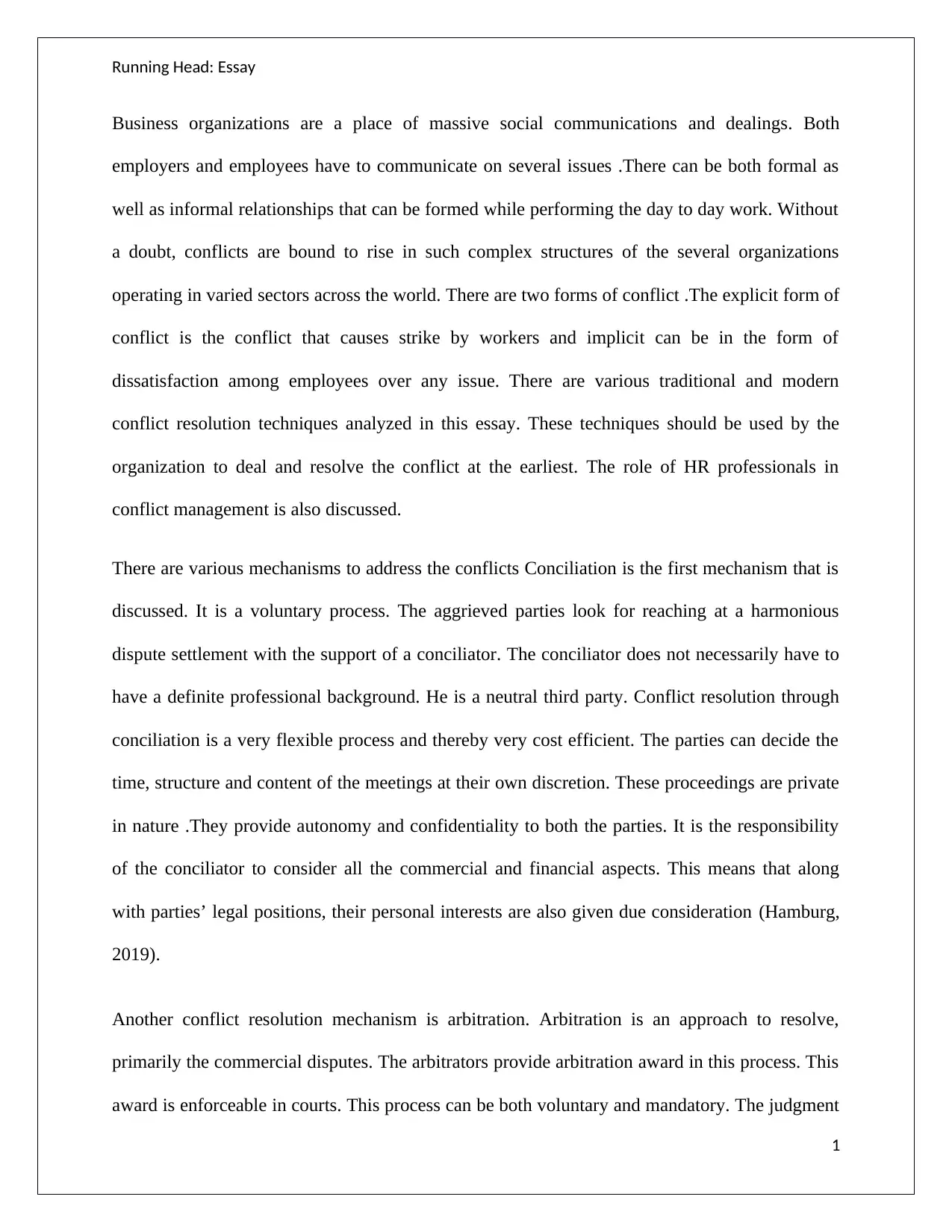
Running Head: Essay
Business organizations are a place of massive social communications and dealings. Both
employers and employees have to communicate on several issues .There can be both formal as
well as informal relationships that can be formed while performing the day to day work. Without
a doubt, conflicts are bound to rise in such complex structures of the several organizations
operating in varied sectors across the world. There are two forms of conflict .The explicit form of
conflict is the conflict that causes strike by workers and implicit can be in the form of
dissatisfaction among employees over any issue. There are various traditional and modern
conflict resolution techniques analyzed in this essay. These techniques should be used by the
organization to deal and resolve the conflict at the earliest. The role of HR professionals in
conflict management is also discussed.
There are various mechanisms to address the conflicts Conciliation is the first mechanism that is
discussed. It is a voluntary process. The aggrieved parties look for reaching at a harmonious
dispute settlement with the support of a conciliator. The conciliator does not necessarily have to
have a definite professional background. He is a neutral third party. Conflict resolution through
conciliation is a very flexible process and thereby very cost efficient. The parties can decide the
time, structure and content of the meetings at their own discretion. These proceedings are private
in nature .They provide autonomy and confidentiality to both the parties. It is the responsibility
of the conciliator to consider all the commercial and financial aspects. This means that along
with parties’ legal positions, their personal interests are also given due consideration (Hamburg,
2019).
Another conflict resolution mechanism is arbitration. Arbitration is an approach to resolve,
primarily the commercial disputes. The arbitrators provide arbitration award in this process. This
award is enforceable in courts. This process can be both voluntary and mandatory. The judgment
1
Business organizations are a place of massive social communications and dealings. Both
employers and employees have to communicate on several issues .There can be both formal as
well as informal relationships that can be formed while performing the day to day work. Without
a doubt, conflicts are bound to rise in such complex structures of the several organizations
operating in varied sectors across the world. There are two forms of conflict .The explicit form of
conflict is the conflict that causes strike by workers and implicit can be in the form of
dissatisfaction among employees over any issue. There are various traditional and modern
conflict resolution techniques analyzed in this essay. These techniques should be used by the
organization to deal and resolve the conflict at the earliest. The role of HR professionals in
conflict management is also discussed.
There are various mechanisms to address the conflicts Conciliation is the first mechanism that is
discussed. It is a voluntary process. The aggrieved parties look for reaching at a harmonious
dispute settlement with the support of a conciliator. The conciliator does not necessarily have to
have a definite professional background. He is a neutral third party. Conflict resolution through
conciliation is a very flexible process and thereby very cost efficient. The parties can decide the
time, structure and content of the meetings at their own discretion. These proceedings are private
in nature .They provide autonomy and confidentiality to both the parties. It is the responsibility
of the conciliator to consider all the commercial and financial aspects. This means that along
with parties’ legal positions, their personal interests are also given due consideration (Hamburg,
2019).
Another conflict resolution mechanism is arbitration. Arbitration is an approach to resolve,
primarily the commercial disputes. The arbitrators provide arbitration award in this process. This
award is enforceable in courts. This process can be both voluntary and mandatory. The judgment
1
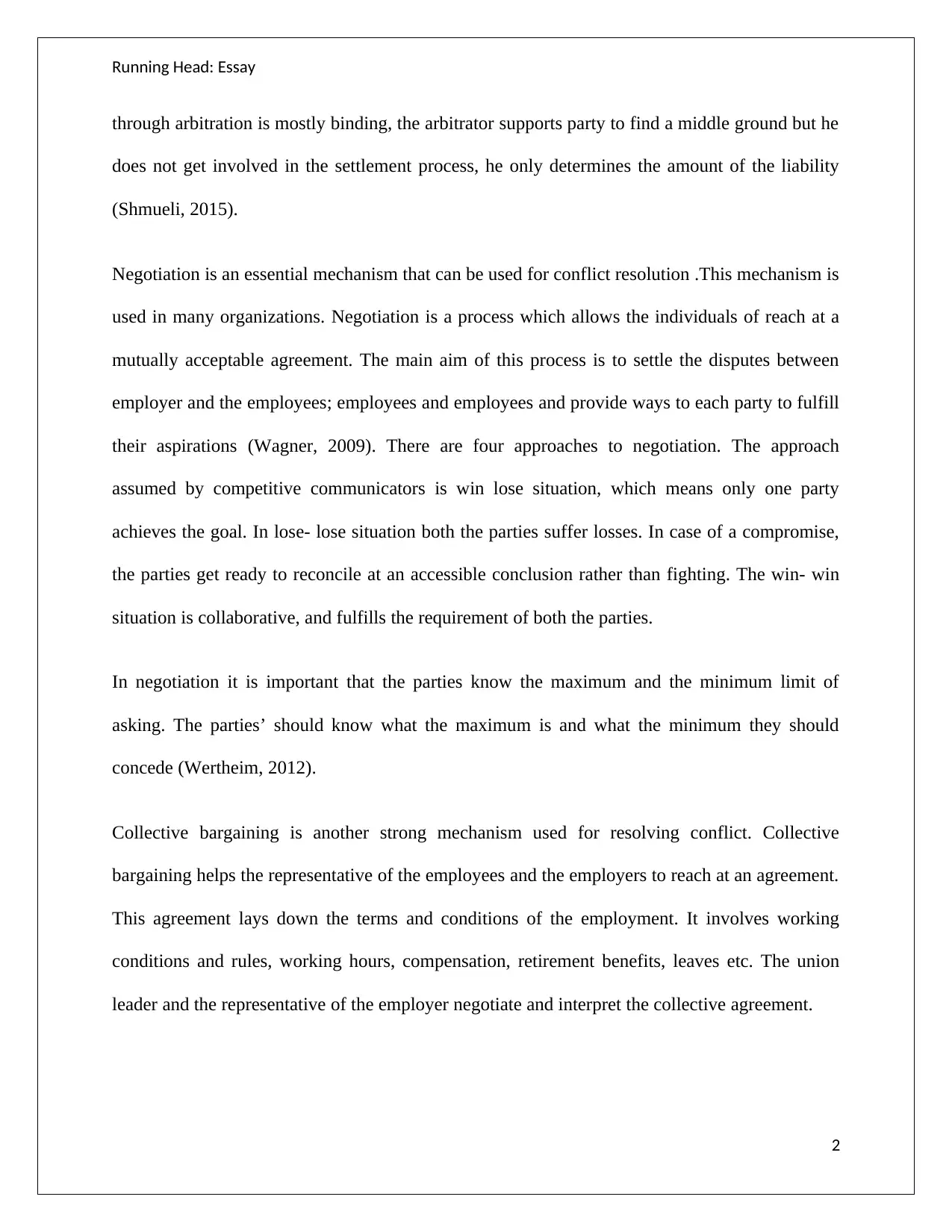
Running Head: Essay
through arbitration is mostly binding, the arbitrator supports party to find a middle ground but he
does not get involved in the settlement process, he only determines the amount of the liability
(Shmueli, 2015).
Negotiation is an essential mechanism that can be used for conflict resolution .This mechanism is
used in many organizations. Negotiation is a process which allows the individuals of reach at a
mutually acceptable agreement. The main aim of this process is to settle the disputes between
employer and the employees; employees and employees and provide ways to each party to fulfill
their aspirations (Wagner, 2009). There are four approaches to negotiation. The approach
assumed by competitive communicators is win lose situation, which means only one party
achieves the goal. In lose- lose situation both the parties suffer losses. In case of a compromise,
the parties get ready to reconcile at an accessible conclusion rather than fighting. The win- win
situation is collaborative, and fulfills the requirement of both the parties.
In negotiation it is important that the parties know the maximum and the minimum limit of
asking. The parties’ should know what the maximum is and what the minimum they should
concede (Wertheim, 2012).
Collective bargaining is another strong mechanism used for resolving conflict. Collective
bargaining helps the representative of the employees and the employers to reach at an agreement.
This agreement lays down the terms and conditions of the employment. It involves working
conditions and rules, working hours, compensation, retirement benefits, leaves etc. The union
leader and the representative of the employer negotiate and interpret the collective agreement.
2
through arbitration is mostly binding, the arbitrator supports party to find a middle ground but he
does not get involved in the settlement process, he only determines the amount of the liability
(Shmueli, 2015).
Negotiation is an essential mechanism that can be used for conflict resolution .This mechanism is
used in many organizations. Negotiation is a process which allows the individuals of reach at a
mutually acceptable agreement. The main aim of this process is to settle the disputes between
employer and the employees; employees and employees and provide ways to each party to fulfill
their aspirations (Wagner, 2009). There are four approaches to negotiation. The approach
assumed by competitive communicators is win lose situation, which means only one party
achieves the goal. In lose- lose situation both the parties suffer losses. In case of a compromise,
the parties get ready to reconcile at an accessible conclusion rather than fighting. The win- win
situation is collaborative, and fulfills the requirement of both the parties.
In negotiation it is important that the parties know the maximum and the minimum limit of
asking. The parties’ should know what the maximum is and what the minimum they should
concede (Wertheim, 2012).
Collective bargaining is another strong mechanism used for resolving conflict. Collective
bargaining helps the representative of the employees and the employers to reach at an agreement.
This agreement lays down the terms and conditions of the employment. It involves working
conditions and rules, working hours, compensation, retirement benefits, leaves etc. The union
leader and the representative of the employer negotiate and interpret the collective agreement.
2
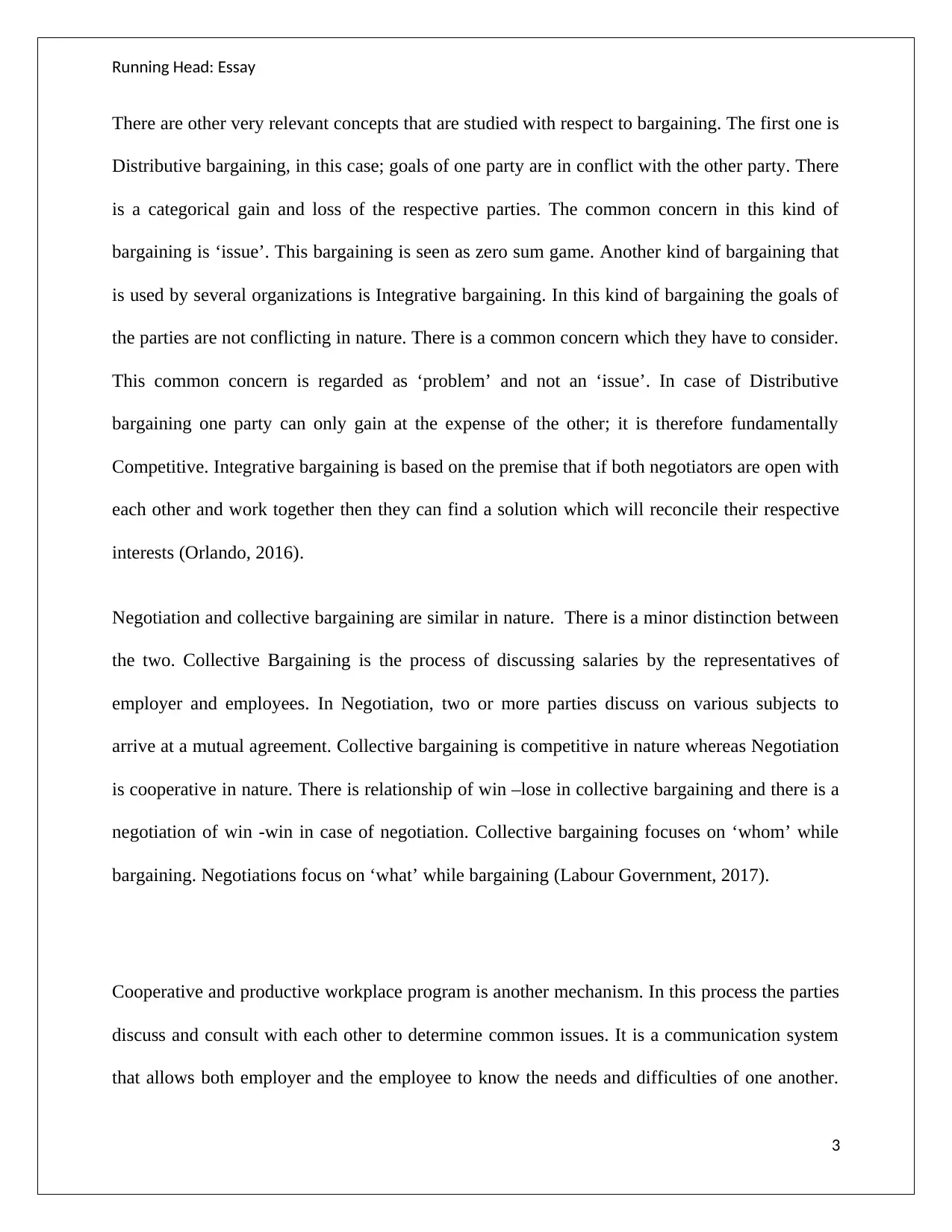
Running Head: Essay
There are other very relevant concepts that are studied with respect to bargaining. The first one is
Distributive bargaining, in this case; goals of one party are in conflict with the other party. There
is a categorical gain and loss of the respective parties. The common concern in this kind of
bargaining is ‘issue’. This bargaining is seen as zero sum game. Another kind of bargaining that
is used by several organizations is Integrative bargaining. In this kind of bargaining the goals of
the parties are not conflicting in nature. There is a common concern which they have to consider.
This common concern is regarded as ‘problem’ and not an ‘issue’. In case of Distributive
bargaining one party can only gain at the expense of the other; it is therefore fundamentally
Competitive. Integrative bargaining is based on the premise that if both negotiators are open with
each other and work together then they can find a solution which will reconcile their respective
interests (Orlando, 2016).
Negotiation and collective bargaining are similar in nature. There is a minor distinction between
the two. Collective Bargaining is the process of discussing salaries by the representatives of
employer and employees. In Negotiation, two or more parties discuss on various subjects to
arrive at a mutual agreement. Collective bargaining is competitive in nature whereas Negotiation
is cooperative in nature. There is relationship of win –lose in collective bargaining and there is a
negotiation of win -win in case of negotiation. Collective bargaining focuses on ‘whom’ while
bargaining. Negotiations focus on ‘what’ while bargaining (Labour Government, 2017).
Cooperative and productive workplace program is another mechanism. In this process the parties
discuss and consult with each other to determine common issues. It is a communication system
that allows both employer and the employee to know the needs and difficulties of one another.
3
There are other very relevant concepts that are studied with respect to bargaining. The first one is
Distributive bargaining, in this case; goals of one party are in conflict with the other party. There
is a categorical gain and loss of the respective parties. The common concern in this kind of
bargaining is ‘issue’. This bargaining is seen as zero sum game. Another kind of bargaining that
is used by several organizations is Integrative bargaining. In this kind of bargaining the goals of
the parties are not conflicting in nature. There is a common concern which they have to consider.
This common concern is regarded as ‘problem’ and not an ‘issue’. In case of Distributive
bargaining one party can only gain at the expense of the other; it is therefore fundamentally
Competitive. Integrative bargaining is based on the premise that if both negotiators are open with
each other and work together then they can find a solution which will reconcile their respective
interests (Orlando, 2016).
Negotiation and collective bargaining are similar in nature. There is a minor distinction between
the two. Collective Bargaining is the process of discussing salaries by the representatives of
employer and employees. In Negotiation, two or more parties discuss on various subjects to
arrive at a mutual agreement. Collective bargaining is competitive in nature whereas Negotiation
is cooperative in nature. There is relationship of win –lose in collective bargaining and there is a
negotiation of win -win in case of negotiation. Collective bargaining focuses on ‘whom’ while
bargaining. Negotiations focus on ‘what’ while bargaining (Labour Government, 2017).
Cooperative and productive workplace program is another mechanism. In this process the parties
discuss and consult with each other to determine common issues. It is a communication system
that allows both employer and the employee to know the needs and difficulties of one another.
3
Secure Best Marks with AI Grader
Need help grading? Try our AI Grader for instant feedback on your assignments.

Running Head: Essay
This mechanism aims at providing a competitive edge to the business. It helps in building a
motivated, dedicated and efficient team. The main theme of this mechanism is management
support and employee involvement, thereby minimizing misunderstandings at uncertain times.
Workplace cooperative programs are complicated and time consuming but they provide several
advantages like increased productivity and efficiency. Many organizations hold conferences for
the same (Marder, 2019).
Another mechanism used by the organizations is restorative justice. It is a type of criminal justice
in which the court primarily works on repairing the damages forced by the criminal on the
injured party. This justice basically supports the victim of a crime, with the intention of
providing justice to the injured party by imposing a penalty on the criminal. In this system the
crime is not seen as act against the law, rather it is just a dispute between criminal and the injured
party. The Governments are dedicated in intensifying access to this mechanism. This approach
gives comfort to the victims to feel safer and get compensated for the damages. The criminals are
given the opportunity to analyze the cause and effect of their behaviors and take responsibility of
their actions. The processes like these also help in making the societies understand the basic
causes of crime. Mechanisms like these help in encouraging societal well beings and thereby
preventing crimes (Calaby, 2017).
The processes discussed above are deemed very essential for conflict resolutions in the
organizations. It allows the employees to make their own agreements on a clear basis rather than
though a formal investigation. Some of these processes are normally voluntary in nature and both
4
This mechanism aims at providing a competitive edge to the business. It helps in building a
motivated, dedicated and efficient team. The main theme of this mechanism is management
support and employee involvement, thereby minimizing misunderstandings at uncertain times.
Workplace cooperative programs are complicated and time consuming but they provide several
advantages like increased productivity and efficiency. Many organizations hold conferences for
the same (Marder, 2019).
Another mechanism used by the organizations is restorative justice. It is a type of criminal justice
in which the court primarily works on repairing the damages forced by the criminal on the
injured party. This justice basically supports the victim of a crime, with the intention of
providing justice to the injured party by imposing a penalty on the criminal. In this system the
crime is not seen as act against the law, rather it is just a dispute between criminal and the injured
party. The Governments are dedicated in intensifying access to this mechanism. This approach
gives comfort to the victims to feel safer and get compensated for the damages. The criminals are
given the opportunity to analyze the cause and effect of their behaviors and take responsibility of
their actions. The processes like these also help in making the societies understand the basic
causes of crime. Mechanisms like these help in encouraging societal well beings and thereby
preventing crimes (Calaby, 2017).
The processes discussed above are deemed very essential for conflict resolutions in the
organizations. It allows the employees to make their own agreements on a clear basis rather than
though a formal investigation. Some of these processes are normally voluntary in nature and both
4

Running Head: Essay
the parties have the right to revoke it anytime. Efficiently resolving the conflicts helps in
employee retention, lesser absenteeism and stress. It also helps in increasing the performance and
productivity of the organization. Effective workplace resolution mechanisms bring increased
workplace communication and team functioning along with improvement in conflict resolution
skills. They also provide long term assurance to make the employees understand that it is in their
capacity to overcome their differences, negotiate, cooperate and finally become more competent
and confident problem solvers (Gramberg & Teicher, 2015).
If these mechanisms are not used, then harmony in organizations will get disturbed. It would also
give rise to group resentment. This would lead to several negative consequences. Unresolved
conflicts also give rise to stress, leading to employee turnover. When the conflict resolution is
used to discuss various ideas, knowledge base of the representatives grows. The understanding of
various cultures and backgrounds that form varied opinions is increased. The parties are
empowered to take mature decisions.
There are many skills that are required by an HR professional to handle conflict in their
organizations. The most essential skill the HR professional needs to inculcate is assertiveness.
The person should clearly and firmly be able to put across their opinions without being
aggressive. According to theorists in order to be assertive, one must be able to describe the
situation, express the feelings and precisely specify the requirements. It is essential for the HR
professionals to be active listeners, only then they would be able to understand the situation of
the conflicting parties (Lytle, 2015). The HR professionals also need to be emotionally
intelligent, only then they can recognize the emotions of themselves as well as others. They have
the responsibility of helping the conflicting parties to recognize their inappropriate emotions.
5
the parties have the right to revoke it anytime. Efficiently resolving the conflicts helps in
employee retention, lesser absenteeism and stress. It also helps in increasing the performance and
productivity of the organization. Effective workplace resolution mechanisms bring increased
workplace communication and team functioning along with improvement in conflict resolution
skills. They also provide long term assurance to make the employees understand that it is in their
capacity to overcome their differences, negotiate, cooperate and finally become more competent
and confident problem solvers (Gramberg & Teicher, 2015).
If these mechanisms are not used, then harmony in organizations will get disturbed. It would also
give rise to group resentment. This would lead to several negative consequences. Unresolved
conflicts also give rise to stress, leading to employee turnover. When the conflict resolution is
used to discuss various ideas, knowledge base of the representatives grows. The understanding of
various cultures and backgrounds that form varied opinions is increased. The parties are
empowered to take mature decisions.
There are many skills that are required by an HR professional to handle conflict in their
organizations. The most essential skill the HR professional needs to inculcate is assertiveness.
The person should clearly and firmly be able to put across their opinions without being
aggressive. According to theorists in order to be assertive, one must be able to describe the
situation, express the feelings and precisely specify the requirements. It is essential for the HR
professionals to be active listeners, only then they would be able to understand the situation of
the conflicting parties (Lytle, 2015). The HR professionals also need to be emotionally
intelligent, only then they can recognize the emotions of themselves as well as others. They have
the responsibility of helping the conflicting parties to recognize their inappropriate emotions.
5

Running Head: Essay
The HR professionals also need to be empathic to better understand the situations of the
conflicting parties.
The other important skills that the HR professionals need to have to resolve conflicts are the
communication skills. It involves talking, listening, questioning, restating, and making use of
analogies and the art of paraphrasing statements. There are certain behaviors that help in better
communication. They are the awareness to know when to interrupt and when to be silent, ability
to read nonverbal cues and being clear and brief while making a point. The HR professional
needs to focus on giving its employees shared goals. They should ensure that the role of each
individual is clearly defined. It would ultimately help in lowering disagreements. The HR
professionals should also regularly impart training to the employees for being empathic towards
the needs of their team members. Another critical skill for resolving resolutions is Problem
solving skills. These skills help in independently approaching a problem and providing multiple
solutions for it. It is important to handle a problem at an early stage as it helps in averting the
conflict, whereas avoiding it give rise to more conflicts. It is important for the HR professionals
to identify the source of the problem at the earliest and then the available solutions should be
evaluated, by paying heed to several interests and opinions. The HR team should be able to
provide stress management training to the employees because stress can give rise to conflict and
vice versa. If the employees know the strategies of reducing stress, they can resolve
disagreement in a better way. It is studied that conflict gives rise to tough emotions; the
employees should thereby be developed to learn influencing techniques and know how to control
6
The HR professionals also need to be empathic to better understand the situations of the
conflicting parties.
The other important skills that the HR professionals need to have to resolve conflicts are the
communication skills. It involves talking, listening, questioning, restating, and making use of
analogies and the art of paraphrasing statements. There are certain behaviors that help in better
communication. They are the awareness to know when to interrupt and when to be silent, ability
to read nonverbal cues and being clear and brief while making a point. The HR professional
needs to focus on giving its employees shared goals. They should ensure that the role of each
individual is clearly defined. It would ultimately help in lowering disagreements. The HR
professionals should also regularly impart training to the employees for being empathic towards
the needs of their team members. Another critical skill for resolving resolutions is Problem
solving skills. These skills help in independently approaching a problem and providing multiple
solutions for it. It is important to handle a problem at an early stage as it helps in averting the
conflict, whereas avoiding it give rise to more conflicts. It is important for the HR professionals
to identify the source of the problem at the earliest and then the available solutions should be
evaluated, by paying heed to several interests and opinions. The HR team should be able to
provide stress management training to the employees because stress can give rise to conflict and
vice versa. If the employees know the strategies of reducing stress, they can resolve
disagreement in a better way. It is studied that conflict gives rise to tough emotions; the
employees should thereby be developed to learn influencing techniques and know how to control
6
Paraphrase This Document
Need a fresh take? Get an instant paraphrase of this document with our AI Paraphraser
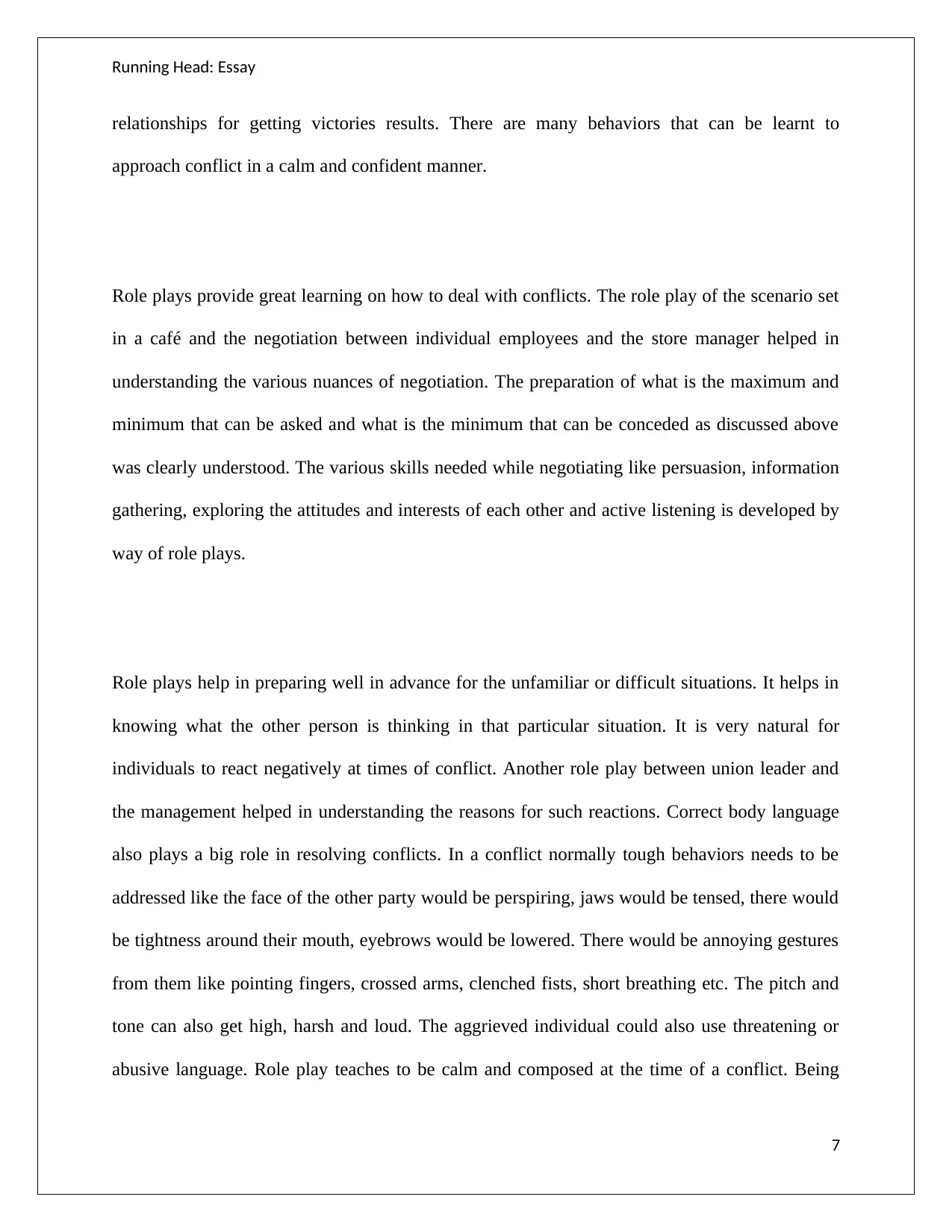
Running Head: Essay
relationships for getting victories results. There are many behaviors that can be learnt to
approach conflict in a calm and confident manner.
Role plays provide great learning on how to deal with conflicts. The role play of the scenario set
in a café and the negotiation between individual employees and the store manager helped in
understanding the various nuances of negotiation. The preparation of what is the maximum and
minimum that can be asked and what is the minimum that can be conceded as discussed above
was clearly understood. The various skills needed while negotiating like persuasion, information
gathering, exploring the attitudes and interests of each other and active listening is developed by
way of role plays.
Role plays help in preparing well in advance for the unfamiliar or difficult situations. It helps in
knowing what the other person is thinking in that particular situation. It is very natural for
individuals to react negatively at times of conflict. Another role play between union leader and
the management helped in understanding the reasons for such reactions. Correct body language
also plays a big role in resolving conflicts. In a conflict normally tough behaviors needs to be
addressed like the face of the other party would be perspiring, jaws would be tensed, there would
be tightness around their mouth, eyebrows would be lowered. There would be annoying gestures
from them like pointing fingers, crossed arms, clenched fists, short breathing etc. The pitch and
tone can also get high, harsh and loud. The aggrieved individual could also use threatening or
abusive language. Role play teaches to be calm and composed at the time of a conflict. Being
7
relationships for getting victories results. There are many behaviors that can be learnt to
approach conflict in a calm and confident manner.
Role plays provide great learning on how to deal with conflicts. The role play of the scenario set
in a café and the negotiation between individual employees and the store manager helped in
understanding the various nuances of negotiation. The preparation of what is the maximum and
minimum that can be asked and what is the minimum that can be conceded as discussed above
was clearly understood. The various skills needed while negotiating like persuasion, information
gathering, exploring the attitudes and interests of each other and active listening is developed by
way of role plays.
Role plays help in preparing well in advance for the unfamiliar or difficult situations. It helps in
knowing what the other person is thinking in that particular situation. It is very natural for
individuals to react negatively at times of conflict. Another role play between union leader and
the management helped in understanding the reasons for such reactions. Correct body language
also plays a big role in resolving conflicts. In a conflict normally tough behaviors needs to be
addressed like the face of the other party would be perspiring, jaws would be tensed, there would
be tightness around their mouth, eyebrows would be lowered. There would be annoying gestures
from them like pointing fingers, crossed arms, clenched fists, short breathing etc. The pitch and
tone can also get high, harsh and loud. The aggrieved individual could also use threatening or
abusive language. Role play teaches to be calm and composed at the time of a conflict. Being
7
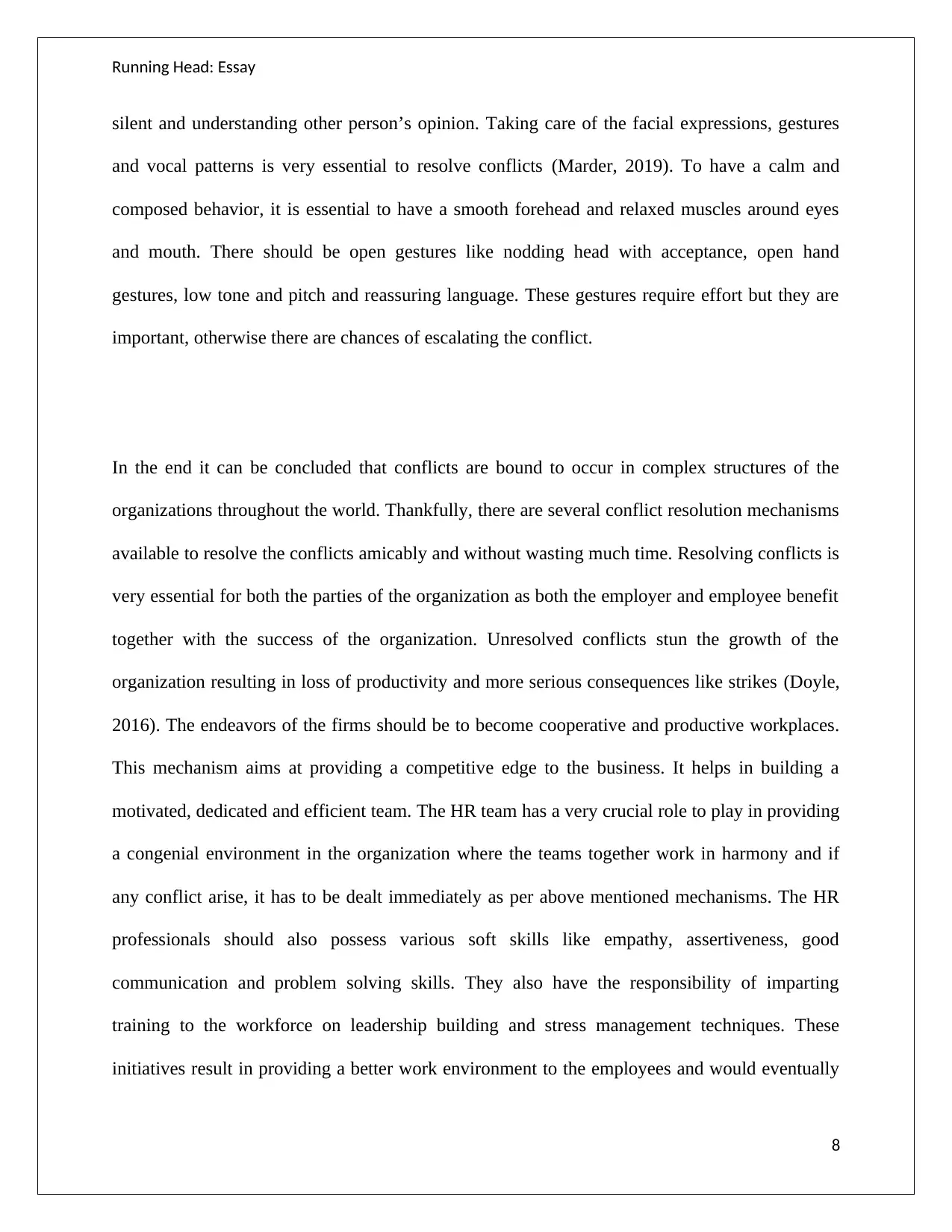
Running Head: Essay
silent and understanding other person’s opinion. Taking care of the facial expressions, gestures
and vocal patterns is very essential to resolve conflicts (Marder, 2019). To have a calm and
composed behavior, it is essential to have a smooth forehead and relaxed muscles around eyes
and mouth. There should be open gestures like nodding head with acceptance, open hand
gestures, low tone and pitch and reassuring language. These gestures require effort but they are
important, otherwise there are chances of escalating the conflict.
In the end it can be concluded that conflicts are bound to occur in complex structures of the
organizations throughout the world. Thankfully, there are several conflict resolution mechanisms
available to resolve the conflicts amicably and without wasting much time. Resolving conflicts is
very essential for both the parties of the organization as both the employer and employee benefit
together with the success of the organization. Unresolved conflicts stun the growth of the
organization resulting in loss of productivity and more serious consequences like strikes (Doyle,
2016). The endeavors of the firms should be to become cooperative and productive workplaces.
This mechanism aims at providing a competitive edge to the business. It helps in building a
motivated, dedicated and efficient team. The HR team has a very crucial role to play in providing
a congenial environment in the organization where the teams together work in harmony and if
any conflict arise, it has to be dealt immediately as per above mentioned mechanisms. The HR
professionals should also possess various soft skills like empathy, assertiveness, good
communication and problem solving skills. They also have the responsibility of imparting
training to the workforce on leadership building and stress management techniques. These
initiatives result in providing a better work environment to the employees and would eventually
8
silent and understanding other person’s opinion. Taking care of the facial expressions, gestures
and vocal patterns is very essential to resolve conflicts (Marder, 2019). To have a calm and
composed behavior, it is essential to have a smooth forehead and relaxed muscles around eyes
and mouth. There should be open gestures like nodding head with acceptance, open hand
gestures, low tone and pitch and reassuring language. These gestures require effort but they are
important, otherwise there are chances of escalating the conflict.
In the end it can be concluded that conflicts are bound to occur in complex structures of the
organizations throughout the world. Thankfully, there are several conflict resolution mechanisms
available to resolve the conflicts amicably and without wasting much time. Resolving conflicts is
very essential for both the parties of the organization as both the employer and employee benefit
together with the success of the organization. Unresolved conflicts stun the growth of the
organization resulting in loss of productivity and more serious consequences like strikes (Doyle,
2016). The endeavors of the firms should be to become cooperative and productive workplaces.
This mechanism aims at providing a competitive edge to the business. It helps in building a
motivated, dedicated and efficient team. The HR team has a very crucial role to play in providing
a congenial environment in the organization where the teams together work in harmony and if
any conflict arise, it has to be dealt immediately as per above mentioned mechanisms. The HR
professionals should also possess various soft skills like empathy, assertiveness, good
communication and problem solving skills. They also have the responsibility of imparting
training to the workforce on leadership building and stress management techniques. These
initiatives result in providing a better work environment to the employees and would eventually
8
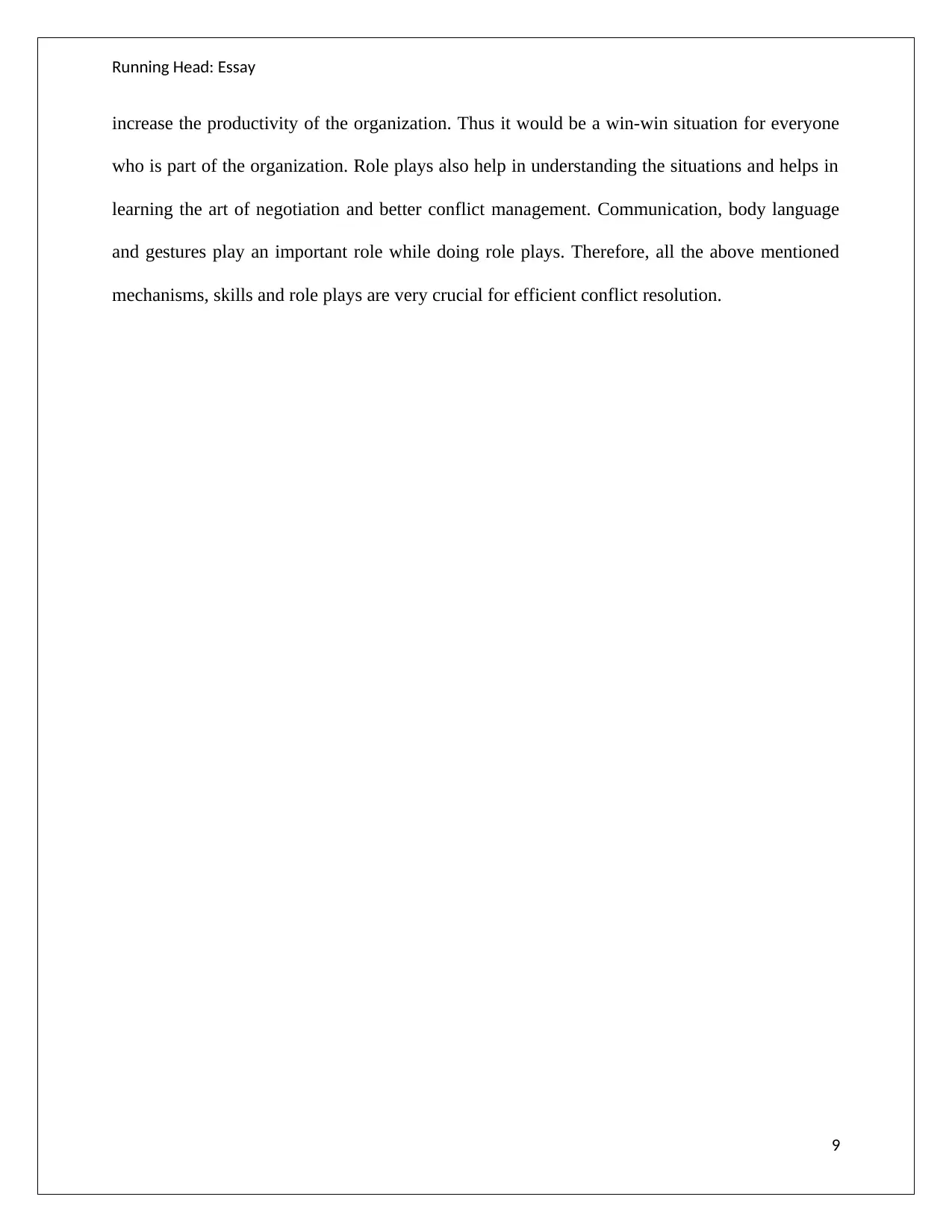
Running Head: Essay
increase the productivity of the organization. Thus it would be a win-win situation for everyone
who is part of the organization. Role plays also help in understanding the situations and helps in
learning the art of negotiation and better conflict management. Communication, body language
and gestures play an important role while doing role plays. Therefore, all the above mentioned
mechanisms, skills and role plays are very crucial for efficient conflict resolution.
9
increase the productivity of the organization. Thus it would be a win-win situation for everyone
who is part of the organization. Role plays also help in understanding the situations and helps in
learning the art of negotiation and better conflict management. Communication, body language
and gestures play an important role while doing role plays. Therefore, all the above mentioned
mechanisms, skills and role plays are very crucial for efficient conflict resolution.
9
Secure Best Marks with AI Grader
Need help grading? Try our AI Grader for instant feedback on your assignments.
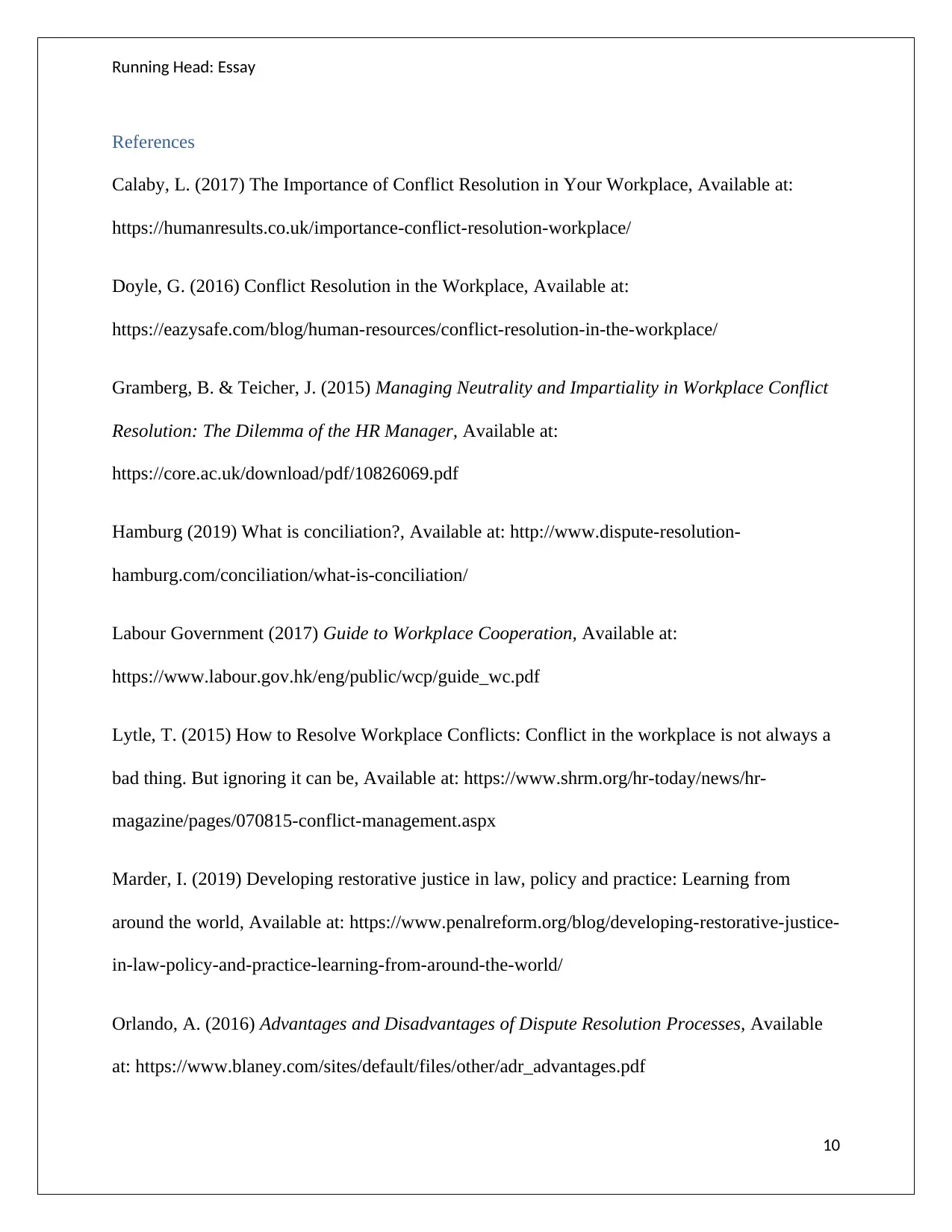
Running Head: Essay
References
Calaby, L. (2017) The Importance of Conflict Resolution in Your Workplace, Available at:
https://humanresults.co.uk/importance-conflict-resolution-workplace/
Doyle, G. (2016) Conflict Resolution in the Workplace, Available at:
https://eazysafe.com/blog/human-resources/conflict-resolution-in-the-workplace/
Gramberg, B. & Teicher, J. (2015) Managing Neutrality and Impartiality in Workplace Conflict
Resolution: The Dilemma of the HR Manager, Available at:
https://core.ac.uk/download/pdf/10826069.pdf
Hamburg (2019) What is conciliation?, Available at: http://www.dispute-resolution-
hamburg.com/conciliation/what-is-conciliation/
Labour Government (2017) Guide to Workplace Cooperation, Available at:
https://www.labour.gov.hk/eng/public/wcp/guide_wc.pdf
Lytle, T. (2015) How to Resolve Workplace Conflicts: Conflict in the workplace is not always a
bad thing. But ignoring it can be, Available at: https://www.shrm.org/hr-today/news/hr-
magazine/pages/070815-conflict-management.aspx
Marder, I. (2019) Developing restorative justice in law, policy and practice: Learning from
around the world, Available at: https://www.penalreform.org/blog/developing-restorative-justice-
in-law-policy-and-practice-learning-from-around-the-world/
Orlando, A. (2016) Advantages and Disadvantages of Dispute Resolution Processes, Available
at: https://www.blaney.com/sites/default/files/other/adr_advantages.pdf
10
References
Calaby, L. (2017) The Importance of Conflict Resolution in Your Workplace, Available at:
https://humanresults.co.uk/importance-conflict-resolution-workplace/
Doyle, G. (2016) Conflict Resolution in the Workplace, Available at:
https://eazysafe.com/blog/human-resources/conflict-resolution-in-the-workplace/
Gramberg, B. & Teicher, J. (2015) Managing Neutrality and Impartiality in Workplace Conflict
Resolution: The Dilemma of the HR Manager, Available at:
https://core.ac.uk/download/pdf/10826069.pdf
Hamburg (2019) What is conciliation?, Available at: http://www.dispute-resolution-
hamburg.com/conciliation/what-is-conciliation/
Labour Government (2017) Guide to Workplace Cooperation, Available at:
https://www.labour.gov.hk/eng/public/wcp/guide_wc.pdf
Lytle, T. (2015) How to Resolve Workplace Conflicts: Conflict in the workplace is not always a
bad thing. But ignoring it can be, Available at: https://www.shrm.org/hr-today/news/hr-
magazine/pages/070815-conflict-management.aspx
Marder, I. (2019) Developing restorative justice in law, policy and practice: Learning from
around the world, Available at: https://www.penalreform.org/blog/developing-restorative-justice-
in-law-policy-and-practice-learning-from-around-the-world/
Orlando, A. (2016) Advantages and Disadvantages of Dispute Resolution Processes, Available
at: https://www.blaney.com/sites/default/files/other/adr_advantages.pdf
10
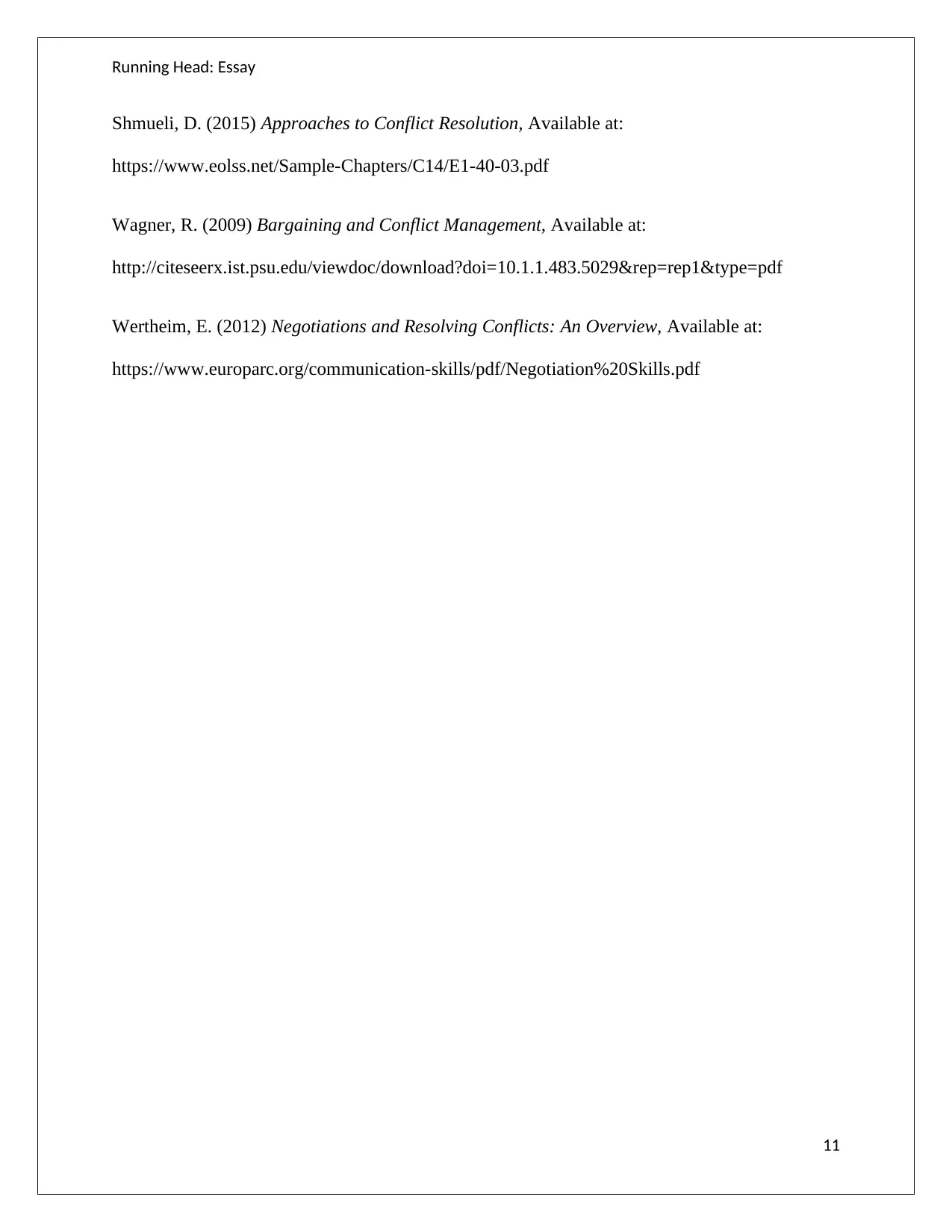
Running Head: Essay
Shmueli, D. (2015) Approaches to Conflict Resolution, Available at:
https://www.eolss.net/Sample-Chapters/C14/E1-40-03.pdf
Wagner, R. (2009) Bargaining and Conflict Management, Available at:
http://citeseerx.ist.psu.edu/viewdoc/download?doi=10.1.1.483.5029&rep=rep1&type=pdf
Wertheim, E. (2012) Negotiations and Resolving Conflicts: An Overview, Available at:
https://www.europarc.org/communication-skills/pdf/Negotiation%20Skills.pdf
11
Shmueli, D. (2015) Approaches to Conflict Resolution, Available at:
https://www.eolss.net/Sample-Chapters/C14/E1-40-03.pdf
Wagner, R. (2009) Bargaining and Conflict Management, Available at:
http://citeseerx.ist.psu.edu/viewdoc/download?doi=10.1.1.483.5029&rep=rep1&type=pdf
Wertheim, E. (2012) Negotiations and Resolving Conflicts: An Overview, Available at:
https://www.europarc.org/communication-skills/pdf/Negotiation%20Skills.pdf
11
1 out of 12
Related Documents
Your All-in-One AI-Powered Toolkit for Academic Success.
+13062052269
info@desklib.com
Available 24*7 on WhatsApp / Email
![[object Object]](/_next/static/media/star-bottom.7253800d.svg)
Unlock your academic potential
© 2024 | Zucol Services PVT LTD | All rights reserved.





